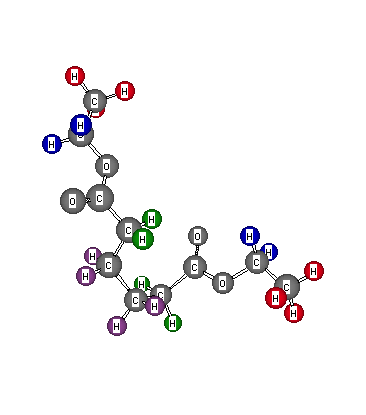NMR: Novice Level, Spectrum 20
Formula: C10H18O4
Answer: Diethyl adipate
Chemical Shift Assignments:
1H NMR: δ 1.25 (3H, t, J = 7 Hz), 1.66 (2H, m), 2.31 (2H, m), and 4.12 (2H, quartet, 1H, J = 7 Hz)
13C NMR: 173.0, 60.2, 33.8, 24.3, and 14.1 ppm
The formula indicates two degree of unsaturation. The integration is half the number of hydrogens in the 1H NMR integration. Moreover, the 13C spectrum reveals only six carbons. Symmetry is present. The signals at δ 1.25 and 4.12 in the 1H NMR spectrum comprise an ethyl pattern with an attachment to a heteroatom-- namely, oxygen. The 13C NMR signal at 173 ppm indicates an ester. Thus, there are two -C(O)OC2H5 groups. These two groups constitute C6H10O4, which leaves C4H8. These hydrogens are of two types, located at d 1.66 and 2.31. A chain of methylenes, -CH2CH2CH2CH2- , is in order. Clearly, the lower field signals are the two methylene groups adjacent to the carbonyl groups. A first approximation based upon chemical equivalence would argue that each of the two methylene groups should appear as a triplet. A careful inspection of these signals shows that they are broad and less well-defined than what one might expect. Eighteen of the preceding 1H NMR spectra have involved only chemically equivalent protons. Because we have duplicate sets of chemically equivalent hydrogens, a new phenomenon can arise --- magnetic non-equivalence. Imagine that one pair of methylene hydrogens at δ 2.31 has spins ββ and the other pair at δ 2.31 has spins αβ. Now each of the methylene groups at δ 1.66 is in a slightly different magnetic environment. Consequently, they couple to one another to provide a complex pattern. The same argument can be made for the complexity of the signal at δ 2.31 caused by the hydrogens at δ 1.66. You may wish to re-evaluate the fine structure of 1H NMR #5 in the Novice Level and explore example #18 in the Intermediate Level. Return to Menu.
 |
oxygen-orange |
|---|